History
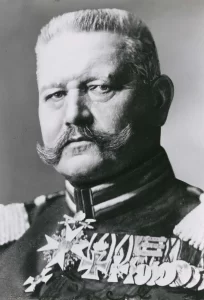 I think most of us have heard the name Hindenburg in some version or another. Whether it’s the airship disaster of 1937; the man himself, Paul von Hindenburg; or the Hindenburg Line of World War I, the name is known. Paul von Hindenburg was born into an aristocratic family on October 2, 1847, in Posen, Prussia, which is present-day Pozna?, Poland. His father was a Prussian military officer-turned-government official, who was granted a title of nobility in 1869; and his mother was the daughter of a doctor.
I think most of us have heard the name Hindenburg in some version or another. Whether it’s the airship disaster of 1937; the man himself, Paul von Hindenburg; or the Hindenburg Line of World War I, the name is known. Paul von Hindenburg was born into an aristocratic family on October 2, 1847, in Posen, Prussia, which is present-day Pozna?, Poland. His father was a Prussian military officer-turned-government official, who was granted a title of nobility in 1869; and his mother was the daughter of a doctor.
Hindenburg joined the Prussian army when he was 19, amid the Austro-Prussian War in 1866, which was also referred to as the Seven Weeks’ War…a significant event leading up to the unification of Germany. Hindenburg fulfilled the role of a staff officer in the Franco-Prussian War from 1870 to 1871 and ultimately rose to the rank of lieutenant general.
After a long military career, Hindenburg retired in 1911, at the age of 64. Then, with the onset of World War I in 1914, he was recalled to active service. As commander of the Eighth Army, he was elevated to the rank of field marshal and achieved a string of victories over the Russians on the Eastern Front, cementing his status as a national hero. One battle that stands out was the Battle of Tannenberg in Poland. Under his command, alongside his chief of staff General Erich Ludendorff, it became one of Germany’s most decisive triumphs of the war.
Anna von der Golz wrote a book called Hindenburg, in which she is quotes as saying, “Soon after the outbreak of war Hindenburg became Germany’s major symbol of victory against the enemy and of unity at home–a function traditionally performed by the Emperor in wartime, or perhaps on occasion by the Chief of the General Staff, but certainly not by the commander of a single German army.”
The phrase “Hindenburg will sort it out,” swiftly turned into a catchphrase, and depictions of the field marshal proliferated, she said. Hindenburg was named chief of the German General Staff by Kaiser Wilhelm entrusting him with the army’s command. Still, the Allies still managed to inflict a decisive defeat.
Following Germany’s defeat in World War I, Hindenburg retired from the military for the second time and entered politics. In 1925, at the age of 77, the “Victor of Tannenberg” was elected as the president of the democratic Weimar Republic (1919-1933), becoming Germany’s second president. He was re-elected in 1932.
In an effort to stabilize the region after the war and the harsh conditions of the Armistice of Compiègne, Hindenburg resorted to issuing presidential emergency decrees, not a real good move on his part. Nevertheless, it was permitted by the nation’s constitution in times of disturbance and economic distress. These decrees enabled him to bypass the German parliament’s consent, suppress his political adversaries, curtail free speech and other civil liberties, and permit military leaders to dictate foreign policy.

Hindenburg was initially a critic of Hitler and the Nazi Party, so at first, he declined to bestow upon Hitler the chancellorship he sought. However, under pressure from his conservative advisors and due to the rising influence of the Nazi Party, he eventually named Hitler as chancellor, reassured by his advisors that they could contain the Nazi program. That was likely his biggest mistake. Hitler swiftly utilized Hindenburg’s decree powers to enact several mandates, including the 1933 Reichstag Fire Decree, the Enabling Act, and the Law for the Protection of the People and the State.
As Hindenburg’s health declined, his appointment effectively granted Hitler dictatorial powers. Upon Hindenburg’s death at age 86 on August 2, 1934, Hitler declared himself the Führer of Germany. Hindenburg was buried alongside his wife, Gertrud von Sperling, who passed away in 1921, at the Tannenberg war memorial in Prussia. Their remains were later transferred to Saint Elizabeth Church in Marburg, Germany, in 1946.
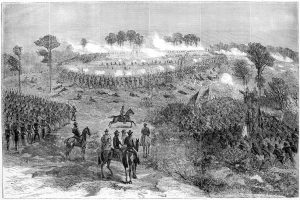
 In the latter part of September 1864, in the middle of the Civil War’s second half, the Union Army targeted Fort Harrison, a key Confederate stronghold. Capturing Richmond, Virginia, hinged on taking Fort Harrison, crucial to General Butler’s offensive strategy. As the most formidable segment of the Confederate defense line, Fort Harrison offered a clear view to the James River, rendering surprise attacks nearly impossible. Following intense summer skirmishes along Petersburg, Virginia’s earthworks, and a toll of around 27,000 casualties since June, a haunting silence had settled over the region. The II Army Corps, led by Major General Winfield Hancock and previously the backbone of Major General George G Meade’s Army of the Potomac, was now severely weakened. Positioned near Petersburg, the II Army Corps was tasked with monitoring and preventing any maneuvering of General Robert E Lee’s combat forces across the James River.
In the latter part of September 1864, in the middle of the Civil War’s second half, the Union Army targeted Fort Harrison, a key Confederate stronghold. Capturing Richmond, Virginia, hinged on taking Fort Harrison, crucial to General Butler’s offensive strategy. As the most formidable segment of the Confederate defense line, Fort Harrison offered a clear view to the James River, rendering surprise attacks nearly impossible. Following intense summer skirmishes along Petersburg, Virginia’s earthworks, and a toll of around 27,000 casualties since June, a haunting silence had settled over the region. The II Army Corps, led by Major General Winfield Hancock and previously the backbone of Major General George G Meade’s Army of the Potomac, was now severely weakened. Positioned near Petersburg, the II Army Corps was tasked with monitoring and preventing any maneuvering of General Robert E Lee’s combat forces across the James River.
At that moment, Major General Benjamin Butler knew he needed to devise a strategy to turn the tide. The pause in activity presented an ideal opportunity for action. Butler considered that during such lulls, there’s often a slight drop in vigilance—just enough, he surmised, for a surprise attack. With this in mind, Butler approached Lieutenant General Ulysses S Grant with a plan. The strategy involved relocating the Army of the James north of the James River to initiate an assault on the Confederate Outer Defenses near Richmond. The objective of the Federal Army of the James was to seize control of the road network southeast of the Confederate Capital, ultimately aiming to capture Richmond itself. 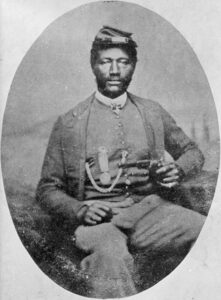
Before Petersburg, there was little activity, but the situation was changing rapidly in the Shenandoah Valley. The battle at Fisher’s Hill occurred on September 22, 1864, resulting in numerous casualties, notably the death of Brigadier General William Nelson Pendleton’s son. Grant’s staff officers were against the subsequent boat journey up the James River, yet Benjamin Butler persuaded Grant to deploy the Army of the James for a northern offensive. The strategy was straightforward. The Confederates underestimated the Federal Armies’ ability to mount a significant offensive towards Richmond from the north, as they had troops defending the earthworks there, leading them to allocate their forces elsewhere. Even with General Robert E Lee’s focus on the north, the Confederate forces in the outer defenses were critically understrength. It was believed that if a genuine threat emerged in that area, Confederate troops could swiftly reinforce the defenses before an attack could be initiated. On the night of September 28-29, 1864, Major General Benjamin Butler convened his top officers for a briefing on the planned movements of his army. Major General Edward O C Ord of the 18th Army Corps, Major General David B Birney of the 10th Army Corps, and Brigadier General August V Kautz of the Cavalry Division were present.
The strategy involved Major General Ord and the 18th Army Corps making an unexpected crossing of the James River at Aiken’s Landing, then advancing up Varina Road. Their goal was to destroy the Confederate bridges at Chaffin’s Bluff before heading up Osbourne Road towards Richmond. At the same time, the 10th Corps, led by Major General Birney, would push forward from Deep Bottom to seize New Market Heights. Moving northwest, Birney’s divisions would proceed up New Market Road towards the Confederate capital. Meanwhile, Brigadier General Kautz’s cavalry was to dash down Darbytown Road towards Richmond. Unfortunately for the South, on September 29, 1864, the plan partially unraveled when 2,500 Union soldiers from Major General Benjamin Butler’s Army of the James overwhelmed Major Richard Cornelius Taylor’s 200-man Confederate garrison, taking the fort in the Battle of Chaffin’s Farm. The operation saw the unfortunate death of Brigadier General Hiram Burnham, a brigade commander from Maine in the XVIII Corps. In his memory, Fort Harrison was subsequently renamed Fort Burnham after the Union forces assumed control.
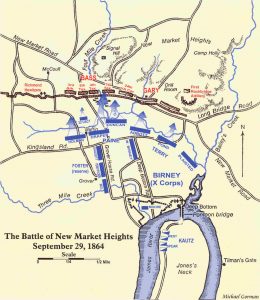
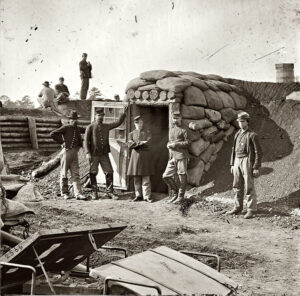 Ultimately, Fort Harrison stood as the sole victory of the day. Although the attempt to capture Richmond was unsuccessful, it quickly pointed out the region’s marked susceptibility. Recognizing the imminent threat to Richmond, General Robert E Lee then commanded a counterattack on September 30. The offensive was unsuccessful, and Brigadier General George J Stannard lost an arm during the resistance to Lee’s assault. This setback compelled the Confederates to reposition their defenses further west. Fort Harrison, also known as Fort Burnham, stayed under Union control until the war was over on November 6, 1865.
Ultimately, Fort Harrison stood as the sole victory of the day. Although the attempt to capture Richmond was unsuccessful, it quickly pointed out the region’s marked susceptibility. Recognizing the imminent threat to Richmond, General Robert E Lee then commanded a counterattack on September 30. The offensive was unsuccessful, and Brigadier General George J Stannard lost an arm during the resistance to Lee’s assault. This setback compelled the Confederates to reposition their defenses further west. Fort Harrison, also known as Fort Burnham, stayed under Union control until the war was over on November 6, 1865.
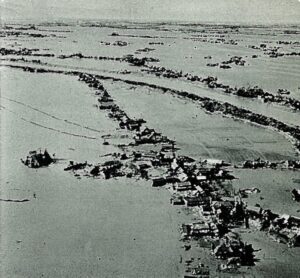
 Typhoon Vera, also known as the Isewan Typhoon, was an extraordinarily powerful tropical cyclone that hit Japan in September 1959. It became the most intense and deadliest typhoon to ever make landfall in the country, and it remains the only one to have done so as a Category 5 equivalent storm. The typhoon caused unprecedented catastrophic damage, severely impacting the Japanese economy, which was in the midst of post-World War II recovery. Following Vera, Japan underwent significant reforms in disaster management and relief operations, establishing a new standard for handling future storms. The country is still well known for its disaster preparedness.
Typhoon Vera, also known as the Isewan Typhoon, was an extraordinarily powerful tropical cyclone that hit Japan in September 1959. It became the most intense and deadliest typhoon to ever make landfall in the country, and it remains the only one to have done so as a Category 5 equivalent storm. The typhoon caused unprecedented catastrophic damage, severely impacting the Japanese economy, which was in the midst of post-World War II recovery. Following Vera, Japan underwent significant reforms in disaster management and relief operations, establishing a new standard for handling future storms. The country is still well known for its disaster preparedness.
Typhoon Vera formed on September 20 between Guam and Chuuk State, initially moving westward before shifting to a northerly path and reaching tropical storm status the next day. The storm then took a turned westward, rapidly intensifying to peak intensity on September 23 with maximum sustained winds that made it Category 5 hurricane. Maintaining its strength, Vera veered northward and made landfall near Shionomisaki on Honshu on September 26. Influenced by atmospheric winds, the typhoon briefly entered the Sea of Japan, then recurved eastward, making a second landfall on Honshu. Crossing over land significantly weakened Vera, and 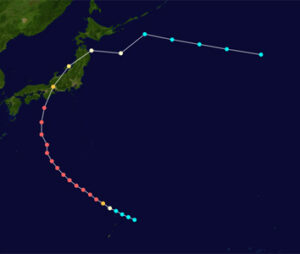
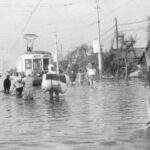 upon reentering the North Pacific Ocean that same day, it became an extratropical cyclone on September 27, with its remnants lasting two more days.
upon reentering the North Pacific Ocean that same day, it became an extratropical cyclone on September 27, with its remnants lasting two more days.
Although Vera’s path into Japan was accurately predicted, the limited telecommunications coverage, combined with the Japanese media’s lack of urgency and the storm’s severity, significantly hindered evacuation and disaster prevention efforts. The flooding from the storm’s peripheral rainbands started affecting river basins before the typhoon made landfall. As it hit Honshu, Vera unleashed a powerful storm surge, destroying many flood defenses, flooding coastal areas, and causing ships to sink. Vera resulted in damages totaling $600 million US dollars, which was equivalent to $6.27 billion US dollars in 2023. The death toll from Vera is uncertain, but current figures suggest the typhoon caused over 5,000 deaths, ranking it among the most lethal typhoons in Japan’s history. Additionally, it injured nearly 39,000 individuals and also displaced around 1.6 million people.
Immediately after Typhoon Vera, the Japanese and American governments launched relief operations. The typhoon’s flooding led to localized outbreaks of diseases such as dysentery and tetanus. These epidemics, along 
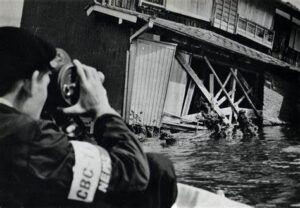 with obstructive debris, hindered the relief process. In response to the extensive damage and casualties caused by Vera, the National Diet, which is the national legislature of Japan, enacted laws to better support the impacted areas and reduce the impact of future disasters. This led to the creation of the Disaster Countermeasures Basic Act in 1961, which laid down guidelines for disaster response in Japan, including forming the Central Disaster Prevention Council.
with obstructive debris, hindered the relief process. In response to the extensive damage and casualties caused by Vera, the National Diet, which is the national legislature of Japan, enacted laws to better support the impacted areas and reduce the impact of future disasters. This led to the creation of the Disaster Countermeasures Basic Act in 1961, which laid down guidelines for disaster response in Japan, including forming the Central Disaster Prevention Council.
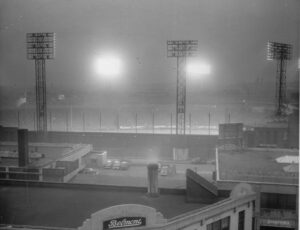
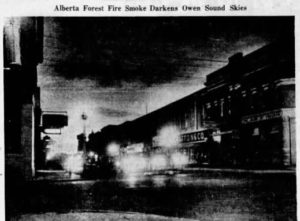 During the summer and early fall of 1950, a series of fires in northern Alberta and northeastern British Columbia consumed around 4 million acres, making it the largest recorded fire in North American history. This event was known as the Chinchaga fire, and it generated smoke that ascended into Earth’s upper atmosphere and covered parts of Canada and the United States by late September, leading to the phenomenon known as the Great Smoke Pall. The dense, black smoke caused midday skies to darken, prompting some to speculate about a nuclear attack. Phone calls started coming in as the people panicked. The impact of the Great Smoke Pall extended as far as Europe.
During the summer and early fall of 1950, a series of fires in northern Alberta and northeastern British Columbia consumed around 4 million acres, making it the largest recorded fire in North American history. This event was known as the Chinchaga fire, and it generated smoke that ascended into Earth’s upper atmosphere and covered parts of Canada and the United States by late September, leading to the phenomenon known as the Great Smoke Pall. The dense, black smoke caused midday skies to darken, prompting some to speculate about a nuclear attack. Phone calls started coming in as the people panicked. The impact of the Great Smoke Pall extended as far as Europe.
The Chinchaga fire, also referred to as “Fire 19” or the Wisp fire, it is believed to have been started by humans near Fort Saint John in Alberta, Canada. During an unusually hot and dry spring, the fire ignited on June 1, 1950, but received little attention from the media. A policy had been put in place to ignore fires in remote areas, much like the “Let it Burn” policy of the 1970s, so authorities allowed it to burn freely. The fire grew into a massive inferno, raging all summer and spreading further with the changing winds and weather fronts.
In September 1950, winds intensified the flames, leading to a significant expansion of the fire. Thick smoke ascended into the atmosphere, encountered an atmospheric trough, and shrouded Ontario before moving towards Ohio and the eastern coast of the United States. On September 24th, the residents of Ontario observed strange hues in the sky. By midday, the smoke had obscured the sunlight, necessitating the activation of streetlights. The whole area took on an eerie tone.
That afternoon, smoke spread along the eastern seaboard. Pilots landing at New York City’s LaGuardia Airport faced zero visibility, necessitating instrument landings. By 4:00 pm, Pennsylvania residents observed unusual colors in the sky, which darkened completely within half an hour. The smoke was so elevated in the atmosphere 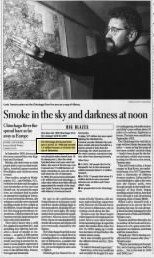
 that it was odorless, and it sparked fears of a nuclear attack among some. Others speculated that an anticipated total lunar eclipse had prematurely begun. Reports of a purple moon abounded, and panic ensued as numerous people feared an apocalyptic event.
that it was odorless, and it sparked fears of a nuclear attack among some. Others speculated that an anticipated total lunar eclipse had prematurely begun. Reports of a purple moon abounded, and panic ensued as numerous people feared an apocalyptic event.
The smoke spread to Western Europe, where high-altitude smoke particles caused the sun to appear blue, intensifying fears of a nuclear attack. By late October 1950, rains and cooler temperatures ultimately put out the fire. The widespread panic induced by the Chinchaga fire prompted the Canadian Forest Service to implement new fire suppression techniques to avert a recurrence. All thoughts of a “Let it Burn” type policy were abandoned…for the time being anyway.

 My dad, Al Spencer, and my niece, Liz Masterson, as well as other of my family members New York Yankees baseball team. Of course, lots of us know about the famous, Babe Ruth and his historic baseball abilities…specifically his famous records, such as an astonishing 56 major league records at the time of his retirement in 1935, including the most revered record in baseball…714 homeruns. Ruth was the first player in baseball history to hit 700 home runs, and he won seven World Series titles, including four with the New York Yankees. His record was the reason that Yankee Stadium was called “the house that Babe Ruth built.”
My dad, Al Spencer, and my niece, Liz Masterson, as well as other of my family members New York Yankees baseball team. Of course, lots of us know about the famous, Babe Ruth and his historic baseball abilities…specifically his famous records, such as an astonishing 56 major league records at the time of his retirement in 1935, including the most revered record in baseball…714 homeruns. Ruth was the first player in baseball history to hit 700 home runs, and he won seven World Series titles, including four with the New York Yankees. His record was the reason that Yankee Stadium was called “the house that Babe Ruth built.”
Of course, as we all know, all good things must come to an end, and the old Yankee Stadium was no exception. The Stadium with its unique design, such as a short porch in right field and covered seats in deep center opened in 1923. The beloved stadium was the scene of scores of Major League Baseball’s most famous moments, including Ruth’s first home run in the stadium on April 18, 1923, Reggie Jackson’s three home-run game to close out the 1977 World Series, and Aaron Boone’s Game 7 walk-off home run in the 2003 American League Championship Series against the Boston Red Sox.
Now, the stadium was getting old, and finally, on September 21, 2008, the stadium witnessed its final game being played. I’m sure it was a sad moment for many Yankees fans. To think that the iconic stadium would cease to exist most likely brought tears to the eyes of many loyal fans. Thankfully, the stadium went down with a win against the Baltimore Orioles, 7-3. Future Hall of Famer Mariano Rivera closed the game with a perfect ninth inning. Who could have asked for anything more…other than maybe not closing down the stadium. Yankees pitcher, Andy Pettitte said, “The way I feel emotionally right now and just physically so drained, it feels like a huge postseason win for us.”
The stadium would go out in typical reverence. The Yankees hosted a pre-game ceremony, allowing fans and former Yankee legends to walk the hallowed grounds a final time. Julia Ruth Stevens, Ruth’s daughter, threw out the ceremonial first pitch as the scoreboard flashed “To Be Continued…” and a photo of “The Bambino” winking. While the iconic final game meant a lot to many people, it was ultimately meaningless in the standings for the 2008 Yankees, who in an ultimately underwhelming season, would miss the playoffs for the first time in more than a decade. But veteran Yankees noted a playoff-like atmosphere. Even some of the retired Yankees, such as Bernie Williams, described pre-game jitters, saying, “I feel as nervous as I was before a playoff game.”
In an effort to encourage the fans who were sad to see the old stadium go, Yankees captain Derek Jeter told the New York faithful to bring the same energy to the “new” Yankee Stadium the next season. “We are relying on you to take the memories from this stadium, add them to the new memories to come at the new Yankee Stadium, and continue to pass them on from generation to generation,” he said. While the 2008 Yankees couldn’t pull off a trip to the playoffs, the 2009 Yankees managed to win another World Series…the fifth and final one of Jeter’s historic career. As for the old Yankee Stadium, it was demolished in 2010, and the site was converted into a public park called Heritage Field. Heritage Field is located on the same plot of land previously occupied by the original Yankee Stadium. It was finally completed in 2012. In a strange twist, there is very little recognition of the history of the ballpark that once stood there. There are only four benches and numerous 
 pavers that list various events that occurred at Yankee Stadium. The site has no featured plaque which describes exactly what was on this spot previously. As to the original Yankee Stadium, the only thing remaining is a large piece of frieze, located in what was the outfield. Heritage Field is nice, but there is a sense of something missing, because of the lack of enough recognition of Yankees baseball history.
pavers that list various events that occurred at Yankee Stadium. The site has no featured plaque which describes exactly what was on this spot previously. As to the original Yankee Stadium, the only thing remaining is a large piece of frieze, located in what was the outfield. Heritage Field is nice, but there is a sense of something missing, because of the lack of enough recognition of Yankees baseball history.
 Margaret Haughery was a philanthropist in the New Orleans area. A philanthropist is “a person who seeks to promote the welfare of others, especially by the generous donation of money to good causes.” She was well known as “the mother of the orphans.” Margaret Gaffney Haughery was such a kind and loving person, and in 1880s New Orleans, she was beyond loved. She was so loved that she was known as “Our Margaret,” “The Bread Woman of New Orleans” and “Mother of Orphans.” The reason, Haughery is so loved is that she devoted her life’s work to the care and feeding of the poor and hungry, and to fund and build orphanages throughout the city.
Margaret Haughery was a philanthropist in the New Orleans area. A philanthropist is “a person who seeks to promote the welfare of others, especially by the generous donation of money to good causes.” She was well known as “the mother of the orphans.” Margaret Gaffney Haughery was such a kind and loving person, and in 1880s New Orleans, she was beyond loved. She was so loved that she was known as “Our Margaret,” “The Bread Woman of New Orleans” and “Mother of Orphans.” The reason, Haughery is so loved is that she devoted her life’s work to the care and feeding of the poor and hungry, and to fund and build orphanages throughout the city.
Haughery was an Irish immigrant, and she was also a widow. Haughery held many titles. She was commonly referred to as the “Angel of the Delta,” “Mother Margaret,” “Margaret of New Orleans,” the “Celebrated Margaret,” “Head Mame,” and “Margaret of Tully.” A Catholic, she worked closely with New Orleans Sisters of Charity, associated with the Roman Catholic Archdiocese of New Orleans. Her work was mainly with poor and orphaned widows and kids. She opened four orphanages in the New Orleans area in the 19th century. She didn’t stop there, however. Many years later in the 20th and 21st centuries, several of the asylums Margaret founded as places of shelter for orphans and widows evolved into homes for the elderly.
After her many long years of working with the needy, Haughery, a woman known for her great work in charity, became famed for her lifelong championing of the destitute. Some people considered her a living saint worthy of canonization. Haughery didn’t have a wealthy start. On the contrary, she was born into poverty and orphaned at a young age. She struggled most of her young life. She then began her adult life as a washwoman and a peddler. Nevertheless, she died a businesswoman and philanthropist and received a state funeral. Her life proves what is said in Luke 6:38 in the Bible, “Give, and it will be given to you. Good measure, pressed down, shaken together, running over, will be put into your lap. For with the measure you use it will be measured back to you.” Haughery was an extravagant giver. It doesn’t mean that she gave tons of money, although over the years, she did. Nevertheless, she gave as much as she could, sometimes even more.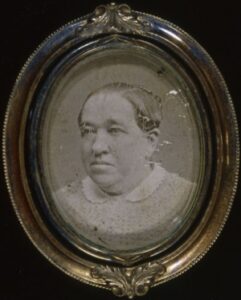
Margaret was born in a stone cottage in Ireland in 1813, the fifth child of William and Margaret O’Rourke Gaffney. The family fell on hard times and the family divided, leaving the three younger children in Ireland with William’s brother. Before long the rest of her family died or, as in the case of her brother, ran off. Haughery was alone and homeless. A Mrs. Richards, who had made the overseas crossing with the Gaffney family heard of Margaret’s plight. She had lost her husband to yellow fever. She took Margaret into her home. There Margaret remained for some years, where she worked for her keep. In fact, she may have been little more than a servant. Margaret received no formal education, and never learned to read or write. When old enough, Margaret went into domestic service, which was common for Irishwomen in Baltimore at that time. While she basically started out with nothing, she received the “kindness” of Mrs Richards and then turned her life around. Margaret went on to show kindness to so many others, and in the end, she became one of the most beloved women in New Orleans.
Margaret married Irish-born Charles Haughery on October 10, 1835, when she was 21 years old. Margaret persuaded him that a change in climate might be therapeutic for his poor health. So, they moved south. They left Baltimore on the ship Hyperion and reached New Orleans on November 20, 1835. Unfortunately, New Orleans was in the middle of yellow fever and cholera epidemics. For a time, Charles’ health showed a slight improvement, but it was short-lived and medical advice recommended a sea journey. In desperation, Charles decided to go to Ireland, which was his native land. The trip had to be delayed for several months pending the birth of the couple’s first child, a girl named Frances. Eventually, Charles made the voyage but after some months Margaret received word that he died shortly after reaching his destination. A short time later, Frances became seriously ill and died. Once again, Margaret’s family was wiped out, and she was just 23 years old. At this point, Margaret Haughery could have given up in despair, but she didn’t. She turned her life around and became one of the most beloved women in New Orleans.
In her will Margaret left everything to charities, without distinction of religion, for widows, orphans, and the 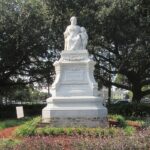 elderly. She left all her wealth to charities with the exception of the bakery, which she bequeathed to her foster son, Bernard Klotz. According to her will, the rest of her wealth. When Margaret died and her will was read, with all her giving, she had still saved a great deal of money. She somehow had given so much, and still had more to give. She left every cent of it to the different orphan asylums of the city. Each orphanage was given something, whether they were for white children or black, for Jews, Catholics, or Protestants, made no difference. Margaret always said, “They are all orphans alike.” Margaret signed her will with a cross instead of a name as she never learned to read or write. Her signature, a reminder of her humble beginnings, great business successes, and mark on humanity, despite being unable to read or write.
elderly. She left all her wealth to charities with the exception of the bakery, which she bequeathed to her foster son, Bernard Klotz. According to her will, the rest of her wealth. When Margaret died and her will was read, with all her giving, she had still saved a great deal of money. She somehow had given so much, and still had more to give. She left every cent of it to the different orphan asylums of the city. Each orphanage was given something, whether they were for white children or black, for Jews, Catholics, or Protestants, made no difference. Margaret always said, “They are all orphans alike.” Margaret signed her will with a cross instead of a name as she never learned to read or write. Her signature, a reminder of her humble beginnings, great business successes, and mark on humanity, despite being unable to read or write.
 Very often, those we would least expect to rise to greatness, show us just how wrong we were. Grace Murray Hopper, at a very young age showed an interest in engineering. She could often be found taking household goods apart. Still, lots of kids have taken things apart, but then Grace would put them back together too. Still, her family had no idea that her curiosity would eventually gain her recognition from the highest office in the land. She was just a curious kid…right? Well, maybe not.
Very often, those we would least expect to rise to greatness, show us just how wrong we were. Grace Murray Hopper, at a very young age showed an interest in engineering. She could often be found taking household goods apart. Still, lots of kids have taken things apart, but then Grace would put them back together too. Still, her family had no idea that her curiosity would eventually gain her recognition from the highest office in the land. She was just a curious kid…right? Well, maybe not.
Hopper was born in New York City on December 9, 1906. She started out in the normal educational way, attending a preparatory school in New Jersey. Then after her high school education ended, she began her journey to greatness. She enrolled at Vassar College. After graduating with her Bachelor’s degree, Hopper went to Yale University, where she earned her Master’s degree and PhD in Mathematics. The she went on to teach at Vassar College.
So, in 1943, Hopper resigned her position at Vassar to join the Navy WAVES (Women Accepted for Voluntary Emergency Service). She felt a higher calling. In 1944, she was commissioned as a Lieutenant (Junior Grade) and assigned to the Bureau of Ordnance Computation Project at Harvard University. She was on her way to that greatness. Her team worked on and produced an early prototype of the electronic computer, called the Mark I. She also wrote a 500-page Manual of Operations for the Automatic Sequence-Controlled Calculator, outlining the fundamental operating principles of computing machines. It was also Hopper that came up with the term “bug” to describe a computer malfunction. We all know that term these days.
When World War II was over Hopper went on to become a research fellow on the Harvard faculty, and in 1949,  she joined the Eckert-Mauchly Corporation, so she could continue her pioneering work on computer technology. When you see things like UNIVAC, the first all-electronic digital computer, think of Hopper. She also invented the first computer compiler, a program that translates written instructions into codes that computers read directly. The work she did on the compiler led her to co-develop the COBOL, which was one of the earliest standardized computer languages. COBOL allows computers to respond to words in addition to numbers. It was an important step into a new era. Along with her work on computers and technical innovation, Hopper also lectured widely on computers, giving up to 300 lectures per year. She saw a world where computers were mainstream. In fact, she predicted that computers would one day be small enough to fit on a desk and people who were not professional programmers would use them in their everyday life. As we all know, that is exactly what has come to pass.
she joined the Eckert-Mauchly Corporation, so she could continue her pioneering work on computer technology. When you see things like UNIVAC, the first all-electronic digital computer, think of Hopper. She also invented the first computer compiler, a program that translates written instructions into codes that computers read directly. The work she did on the compiler led her to co-develop the COBOL, which was one of the earliest standardized computer languages. COBOL allows computers to respond to words in addition to numbers. It was an important step into a new era. Along with her work on computers and technical innovation, Hopper also lectured widely on computers, giving up to 300 lectures per year. She saw a world where computers were mainstream. In fact, she predicted that computers would one day be small enough to fit on a desk and people who were not professional programmers would use them in their everyday life. As we all know, that is exactly what has come to pass.
While her time of active service to her country was behind her, Hopper retained her affiliation with the Naval Reserve throughout her latter career. Moving up, she attained the rank of Commander by 1966. Then, as happens in the reserves sometimes, Hopper was called back to active duty in 1967. She was assigned to the Chief of Naval Operations’ staff as Director of the Navy Programming Languages Group. Hopper continued to move up the ranks, reaching the rank of Captain in 1973, Commodore in 1983, and Rear Admiral in 1985. She  basically had two great careers. In 1987, she was awarded the Defense Distinguished Service Medal, the highest decoration given to those who did not participate in combat. It was a moment to be very proud of.
basically had two great careers. In 1987, she was awarded the Defense Distinguished Service Medal, the highest decoration given to those who did not participate in combat. It was a moment to be very proud of.
While her military career had been amazing, her work with computers wasn’t anything to make light of either. She not only gained national attention, but she was recognized internationally for her work with computers. In 1973, Hopper was named a distinguished fellow of the British Computer Society. At that time, she was the first and only woman to hold the title. Hopper retired, but she couldn’t really retire, so she returned to the classroom, where she taught and inspired students until her death on January 1st, 1992. Throughout her life, Hopper had many career accomplishments, but she later said that her greatest joy came from teaching. In 2016, Hopper was posthumously awarded the Presidential Medal of Freedom. Her body is interred at Arlington National Cemetery.
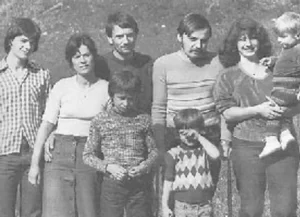 It all happened overnight. The people of East Berlin became prisoners of their government. The government was oppressive, and people wanted to leave. The government could not have that, so walls were put up encircling the city virtually overnight. East Germany was now a part of the Eastern Bloc, and it was separated from West Germany in the Western Bloc by the inner German border and the Berlin Wall, which were heavily fortified with watchtowers, land mines, armed soldiers, and various other measures to prevent illegal crossings. The people were prisoners, and the East German border troops were instructed to prevent defection to West Germany by all means, including lethal force (Schießbefehl; “order to fire”). Many people attempted escape, and many people died trying.
It all happened overnight. The people of East Berlin became prisoners of their government. The government was oppressive, and people wanted to leave. The government could not have that, so walls were put up encircling the city virtually overnight. East Germany was now a part of the Eastern Bloc, and it was separated from West Germany in the Western Bloc by the inner German border and the Berlin Wall, which were heavily fortified with watchtowers, land mines, armed soldiers, and various other measures to prevent illegal crossings. The people were prisoners, and the East German border troops were instructed to prevent defection to West Germany by all means, including lethal force (Schießbefehl; “order to fire”). Many people attempted escape, and many people died trying.
One of the people who refused to give up and settle for imprisonment was Peter Strelzyk (born 1942), an electrician and former East German Air Force mechanic. Strelzyk, along with his friend, Günter Wetzel (born 1955), who was a bricklayer by trade, were determined to get out of East Berlin. The men had been colleagues at a local plastics factory for four years. They had long shared a desire to get out of the country and make a better life for their families. They began discussing, albeit very quietly, how they might make their escape. On March 7, 1978, they decided that they were done living that way and began to plan an escape. Their first thought was to build a helicopter. Then, they realized that they would be unable to acquire an engine capable of powering such a craft. Then, their imaginations alighted on the thought of building a hot air balloon. That idea came about after they watched a television program about ballooning. Some say that they got the idea after a relative shared a magazine article about the International Balloon Festival in Albuquerque, New Mexico. It really doesn’t matter where the idea came from, because they main thing is that they cose a hot air balloon as their escape vehicle.
The decision made, Strelzyk and Wetzel began research into balloons. The plan was to escape with their wives and a total of four children, aged 2 to 15. This was going to have to be a big balloon to hold eight passengers and the basket they would ride in. They calculated the weight of the eight passengers and the craft itself to be around 1,650 pounds. With that in mind, they knew that would need a balloon that could carry the weight would need to hold 71,000 cubic feet of air heated to 212 °F. The next calculation was the amount of material needed for the balloon itself, estimated to be 8,600 square feet.
The pair lived in Pößneck, a small town of about 20,000 where large quantities of cloth could not be obtained without raising attention. There were a number of things that raised suspicion, and a number of people in East Berlin who were all too willing to tell the authorities what they saw and heard. The two men tried neighboring towns of Rudolstadt, Saalfeld, and Jena without success. They travelled 31 miles to Gera, where they were finally able to purchase 3 feet 3 inch wide rolls of cotton cloth totaling 850 2,790 feet in length at a department store after telling the astonished clerk that they needed the large quantity of material to use as tent lining for their camping club.
Wetzel spent two weeks sewing the cloth into a balloon-shaped bag, 49 feet wide by 66 feet long, using a 40-year-old manually operated sewing machine. Strelzyk spent the time building the gondola and burner assembly. The gondola was made from an iron frame, sheet metal floor, and clothesline run around the perimeter every 5.9 inches for the sides. The burner was made using two 24-pound bottles of liquid propane household gas, hoses, water pipe, a nozzle, and a piece of stove pipe.
Finally, in April 1978, the balloon was ready to be tested. For several days, the men searched for just the right spot for the test. The site had to be secluded and yet have a good-sized clearing. They settled on a forest clearing near Ziegenrück, 6.2 miles from the border and 19 miles from Pößneck. Unfortunately, when they tried to inflate the balloon, the heated air from the burner would not move into the balloon. They thought the problem might stem from the fact that they had laid the balloon on the ground. After weeks of additional searching, they found an 82-foot cliff at a rock quarry where they could suspend the balloon vertically before inflation. Unfortunately, that plan also failed.
In the most dramatic invention to date, the men decided to fill the bag with ambient-temperature air before using the burner to raise the air temperature and provide lift. For this, the men constructed a blower with a 14 horsepower 250 cc 15 cubic inch motorcycle engine, started with a Trabant automobile starter powered by jumper cables from Strelzyk’s Moskvitch sedan. The engine, which was quieted by a Trabant muffler. The engine turned 3.3 feet fan blades to inflate the balloon. They also used a home-made flamethrower, similar to the gondola’s burner, to pre-heat the air faster. With these modifications in place, they returned to the secluded clearing to try again, and again the plan failed to inflate the balloon. At this point, they discovered that the cotton material was the problem. It was just too porous, and the heated air quickly seeped out. That unsuccessful attempt had cost them 2,400 DDM. Strelzyk disposed of the cloth by burning it in his furnace over several weeks.
The men went back to the drawing board. Strelzyk and Wetzel purchased samples of different fabrics in local stores, including umbrella material and various samples of taffeta and nylon. Then they used an oven to test the material for heat resistance. They also created a test rig from a vacuum cleaner and a water-filled glass tube to determine which material would allow the vacuum to exert the most suction on the water, and consequently which was the most impervious to air. Of the materials tested, the umbrella covering performed the best, but it was also the most expensive. In the end, they instead selected a synthetic kind of taffeta.
Once again, the men traveled to a distant city to make their purchases so they wouldn’t arouse suspicion. This time they travelled over 100 miles to a department store in Leipzig. Their new cover story was that they belonged to a sailing club and needed the material to make sails. They were extremely worried that the purchase could alert East Germany’s State Security Service (Stasi). Nevertheless, they returned the next day and picked up the material without incident. They paid 4,800 DDM (US$720) for 2,600 feet of 3-foot 3-inch  fabric. On the way home, they also purchased an electric motor to speed up the pedal-operated sewing machine they had been using to sew the material into the desired balloon shape.
fabric. On the way home, they also purchased an electric motor to speed up the pedal-operated sewing machine they had been using to sew the material into the desired balloon shape.
Wetzel spent the next week sewing the material into another balloon. The new motor made the work much faster. Before long they were ready. Soon afterwards, they returned to the forest clearing and inflated the bag in about five minutes using the blower and flame thrower. It was amazing!! Unfortunately, there was s glitch. The bag rose and held air, but the burner on the gondola was not powerful enough to create the heat needed for lift. The pair continued experimenting for months, doubling the number of propane tanks and trying different fuel mixtures. Disappointed with the result, Wetzel decided to abandon the project and instead started to pursue the idea of building a small gasoline engine-powered light aeroplane or a glider.
Strelzyk, however, refused to give up. He continued trying to improve the burner. In June 1979, he discovered that with the propane tank inverted, additional pressure caused the liquid propane to evaporate, which produced a bigger flame. He modified the gondola to mount the propane tanks upside down, and returned to the test site where he found the new configuration produced a 39-foot-long flame. Strelzyk was ready to attempt an escape.
Now down to just four people, the Strelzyk family chose July 3, 1979, and go-day. The weather and wind conditions were favorable. The entire Strelzyk family lifted from a forest clearing at 1:30 am and climbed at a rate of 13 feet per second. They reached an altitude of 6,600 feet according to an altimeter Strelzyk had made by modifying a barometer. A light wind was blowing them towards the border. The balloon then entered clouds, and atmospheric water vapor condensed on the balloon, adding weight which caused it to descend prematurely. The family landed safely…but they were approximately 590 feet short of the border, at the edge of the heavily mined border zone. It was a terrifying situation. At first, they weren’t sure where they were, but Strelzyk explored until he found a piece of litter…a bread bag from a bakery in Wernigerode, an East German town. The terrified family spent nine hours carefully extricating themselves from the 1,600-foot-wide border zone to avoid detection. They also had to travel unnoticed through a 3.1-mile restricted zone before hiking back a total of 8.7 mile to their car and the launch paraphernalia they had left behind. Amazingly, while the balloon was found, their car had not been. They made it home just in time to report absent due to sickness from work and school and go to be to get some much-needed rest.
The abandoned balloon was discovered by the authorities later that morning, and Strelzyk destroyed all compromising evidence and sold his car, fearing that it could link him to the escape attempt. On August 14th, the Stasi launched an appeal to find the “perpetrator of a serious offence” and listed in detail all the items recovered at the landing site. Strelzyk felt that the Stasi would eventually trace the balloon to him and the Wetzels. He agreed with Wetzel that their best chance was to quickly build another balloon and get out as soon as possible.
At this point, Wetzel again joined Strelzyk. They doubled the balloon’s size to 140,000 cubic feet in volume, 66 feet in diameter, and 82 feet in height. They needed 13,500 square feet of taffeta, and purchased the material, in various colors and patterns, all over the country in order to escape suspicion. Wetzel sewed a third balloon, using over 3.7 miles of thread, and Strelzyk rebuilt everything else as before. They worked feverishly, because they knew their time was very limited. The authorities were closing in on them. In six weeks, they had prepared the 400-pound balloon and a payload of 1,210 pound, including the gondola, equipment, and cargo of eight people. Confident in their calculations, they found the weather conditions right on September 15, 1978, when a violent thunderstorm created the correct winds. The two families set off for the launch site in Strelzyk’s replacement car (a Wartburg) and a moped. Arriving at 1:30 am, they needed just ten minutes to inflate the balloon and an additional three minutes to heat the air.
They lifted off just after 2:00 am, and in their hurry, the group failed to cut the tethers holding the gondola to the ground at the same time, tilting the balloon and sending the flame towards the fabric, which caught fire. They quickly got the fire out, because they had prepared for such an emergency. Then the balloon climbed to 6,600 feet in nine minutes, drifting towards West Germany at 9 miles per hour. The balloon flew for 28 minutes, with the temperature plummeting to 18 °F in the unsheltered gondola, which consisted solely of clothesline railing. Nevertheless, they pressed on.
A design miscalculation resulted in the burner stovepipe being too long, causing the flame to be too high in the balloon, creating excessive pressure which caused the balloon to split. While they had to use the burner more that they had hoped, they kept the balloon in the air. At one point, they increased the flame to the maximum possible extent and rose to 8,200 feet. They later learned they had been high enough to be detected, but not identified, on radar by West German air traffic controllers. They had also been detected on the East German side by a night watchman at the district culture house in Bad Lobenstein. The report of an unidentified flying object heading toward the border caused guards to activate search lights, but the balloon was too high and out of reach of the lights. God had protected the families.
When the propane ran out, the balloon descended quickly, landing near the town of Naila, in the West German state of Bavaria and only 6 miles from the border. The only injury was suffered by Wetzel, who broke his leg upon landing. Various clues indicated to the families that the balloon had made it across the border. These included spotting red and yellow colored lights, not common in East Germany, and small farms, in contrast to the large state-run operations in the east. Another clue was modern farm equipment, unlike the older equipment used in East Germany. Two Bavarian State Police officers saw the balloon’s flickering light and headed to where they thought it would land. There they found Strelzyk and Wetzel, who first asked if they had made it to the west, although they noticed the police car was an Audi…another sign they were in West Germany. Upon learning they had, the escapees happily called for their families to join them.
Of course, East Germany immediately increased border security, closed all small airports close to the border, and ordered the planes kept farther inland. Propane gas tanks became registered products, and large quantities of fabric suitable for balloon construction could no longer be purchased. Mail from East Germany to the two escaped families was prohibited.
Erich Strelzyk learned of his brother’s escape on the ZDF news and was arrested three hours after the landing in his Potsdam apartment. The arrest of family members was standard procedure to deter others from attempting escape. He was charged with “aiding and abetting escape”, as were Strelzyk’s sister Maria and her 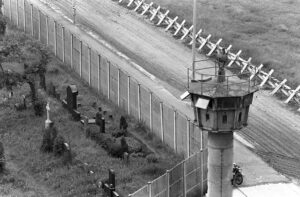 husband, who were sentenced to 2½ years. The three were eventually released with the help of Amnesty International.
husband, who were sentenced to 2½ years. The three were eventually released with the help of Amnesty International.
The families decided to initially settle in Naila where they had landed. Wetzel worked as an automobile mechanic and Strelzyk opened a TV repair shop in Bad Kissingen. Due to pressure from Stasi spies, the Strelzyks moved to Switzerland in 1985. After German reunification in 1990, they returned to their old home in their hometown of Pößneck. The Wetzels remained in Bavaria. Peter Strelzyk died in 2017 at age 74 after a long illness. In 2017, the balloon was put on permanent display at the Haus der Bayerischen Geschichte: Museum in Bavaria.
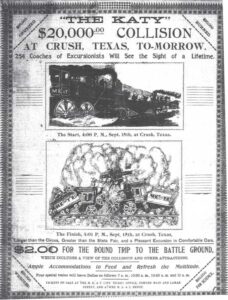
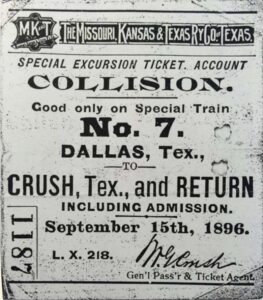 Some of the most horrific kinds of accidents that happen on the railroad are head-on collisions. In these types of accidents, it is almost always the fault of a person, commonly known as “human error.” Once in a while, the signal lights could be defective too, but that is less common than when the person responsible for watching the signal lights is “asleep” at their post, either literally or figuratively. However, on September 15, 1896, neither of these scenarios was the case. Nor was the ensuing crash a terrorist attack. It was actually a planned event. What would make a railway company purposely run two locomotives into each other, head-on? Your guess is as good as mine.
Some of the most horrific kinds of accidents that happen on the railroad are head-on collisions. In these types of accidents, it is almost always the fault of a person, commonly known as “human error.” Once in a while, the signal lights could be defective too, but that is less common than when the person responsible for watching the signal lights is “asleep” at their post, either literally or figuratively. However, on September 15, 1896, neither of these scenarios was the case. Nor was the ensuing crash a terrorist attack. It was actually a planned event. What would make a railway company purposely run two locomotives into each other, head-on? Your guess is as good as mine.
It was actually a publicity stunt. The area north of Waco, was a shallow valley near the tracks of the Missouri, Kansas, and Texas Railroad, also known as the Katy. There was no town there, so a “pop up” town, named Crush, Texas, was formed and was named after William George Crush, who was a passenger agent for the Katy. In 1895, Crush had the crazy idea of staging a train wreck as a way to generate passenger ticket sales. I’m not sure if I would want to buy a ticket for the train, if I had seen the possibility of a head-on collision come to life before my eyes, but apparently some people would. At that time, Texas, like much of the rest of the country, was in a serious economic depression, so Crush convinced the Katy company officials that his scheme would be a creative marketing ploy and attraction. I suppose we all tend to like to watch the spectacular, and a crash of that magnitude…knowing that now one would be hurt…would be interesting.
That summer, the Katy bombarded Texans with advertising for the “Monster Crash.” If they were going to purposely destroy two locomotives and the attached railcars, they wanted plenty of spectators. They put daily preparation reports in many newspapers, and the publicity even stretched beyond the state border. The two locomotives were chosen. They would use Old Number 999, which they painted green, and Number 1001, which they painted red. For a time, they two locomotives toured around to generate interest.
Thousands of Texans came out to see the locomotives during their tour, and then in early September several hundred Katy workmen began staging the town. Obviously not wanting to shut down the main line tracks for the cleanup that would have to follow the crash, they laid four miles of track off of the Waco-Dallas line that would be at a slight downward grade for both engines to the point of impact. A grandstand was constructed, along with three speaker’s stands, a bandstand, telegraph office, and a circus tent to act as a restaurant. The atmosphere was set with a huge carnival midway that featured game booths, drink stands, and medicine 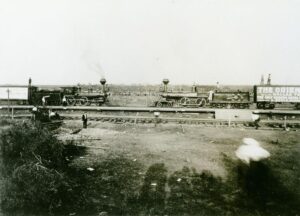 shows. And to put the final touch, they erected a special depot with a 2,100-foot platform and a sign welcoming passengers to Crush, Texas. I suppose it was similar to staging a movie these days.
shows. And to put the final touch, they erected a special depot with a 2,100-foot platform and a sign welcoming passengers to Crush, Texas. I suppose it was similar to staging a movie these days.
It was a known fact that in most collisions of this type, the engines would force each other up into a V and the rest of the cars would accordion behind them, making a boiler explosion less likely. Still, they didn’t want to take any chances, so they set up a safety perimeter of 150 yards around the pre-determined collision point and no one would be allowed in the danger zone. Crush told reporters, “The place selected for the collision is a natural amphitheater, and nobody will have any trouble viewing the entire exhibition.”
Tickets to the event were priced at $2.00, and they expected about 20,000 prople from around the state. What they got, was 40,000 people, and some passengers had too ride on top of railcars to get to the site. On that one day, the town of Crush, Texas became the second largest city in Texas. The event was scheduled for 4pm, but since people were still coming into town, they delayed the collision by one hour. Finally, at 5pm, the two locomotives, each pulling six cars moved into position at opposite ends of the four-mile track. Finally, the spectacle was ready. Crush rode a white horse to the middle of the track, raised his white hat, then after a dramatic pause, whipped it down as the signal for the engines to start. The crowd pressed forward for a better view, and the locomotive crews jumped to safety leaving the massive 35-ton iron monsters on their 50 mile per hour course to disaster. For dramatic effect, the Katy employees had placed small charges along the rail line to create warning blasts as the locomotives passed them.
Unfortunately, Crush and Katy rail officials had underestimated just how powerful the collision would be. The trains hit with between 1 and 2 million pounds of force, and despite what the engineers thought would happen, the boilers on both exploded. The sound of the collision was deafening, and the collision filled the air with flying metal. The panicked crowds tried to run to safety. The debris, ranging from the size of a postage stamp to half a driving wheel, rained down of the crowd for about 300 yards. Sadly, not everyone would make it out alive. At least two people were killed, and several injured. Shockingly, some of the injuries occurred after the crash when spectators rushed to collect souvenirs, not realizing it would burn their hands. Waco based photographer Jervice Deane, lost his right eye to a flying bolt that lodged in his skull. Amazingly, he survived the injury.
The planned disaster was quickly cleaned up by railroad crews and souvenir hunters, and by nightfall, the town of Crush ceased to exist. For his part in all this, Katy rail officials fired George Crush that night, because they 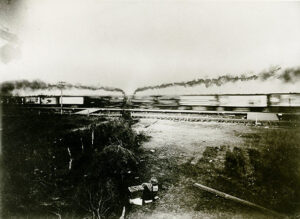
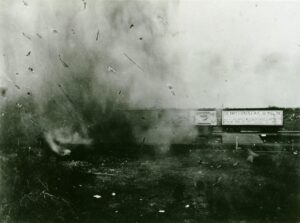 were anticipating a large backlash and lawsuits resulting from the larger than expected explosion. Nevertheless, the publicity stunt worked, train ticket sales increased. In a “back by popular demand” kind of move, Crush was re-hired within days. His days as a showman, however, were over. The railroad quietly settled the resulting lawsuits with cash and lifetime rail passes. Crush stayed on with the railroad until his retirement in 1940.
were anticipating a large backlash and lawsuits resulting from the larger than expected explosion. Nevertheless, the publicity stunt worked, train ticket sales increased. In a “back by popular demand” kind of move, Crush was re-hired within days. His days as a showman, however, were over. The railroad quietly settled the resulting lawsuits with cash and lifetime rail passes. Crush stayed on with the railroad until his retirement in 1940.

 Many little girls dream of becoming a princess. They may not dream of it for long, before reality sets in, but at some point, most little girls want to be a princess, even if it is just Cinderella. For one actress, Grace Kelly, that dream came true on April 18, 1956, when she married Prince Rainier III of Monaco. The couple met the year before at the Cannes Film Festival, went on to have three children…Caroline, born January 23, 1957; Albert II, born March 14, 1958; and Stephanie, born February 1, 1965.
Many little girls dream of becoming a princess. They may not dream of it for long, before reality sets in, but at some point, most little girls want to be a princess, even if it is just Cinderella. For one actress, Grace Kelly, that dream came true on April 18, 1956, when she married Prince Rainier III of Monaco. The couple met the year before at the Cannes Film Festival, went on to have three children…Caroline, born January 23, 1957; Albert II, born March 14, 1958; and Stephanie, born February 1, 1965.
Grace Kelly, the daughter of a former model and a wealthy industrialist, was born on November 12, 1929, in Philadelphia. Her talent was obvious early on, and she began acting as a child. Then, after high school, she attended the American Academy for Dramatic Arts in New York. She had found her niche…or so she thought.  After her schooling, she began to audition for Broadway plays. She was a classic blonde beauty, who supported herself by modeling and appearing in TV commercials, while awaiting her “big break.”
After her schooling, she began to audition for Broadway plays. She was a classic blonde beauty, who supported herself by modeling and appearing in TV commercials, while awaiting her “big break.”
In 1949, Kelly debuted on Broadway in a play called “The Father” by August Strindberg. She was on her way. Then two years later, she landed her first Hollywood part. Granted, it was a bit part, in a movie called “Fourteen Hours,” but it was a part. Her big break came in 1952, when she starred as Gary Cooper’s wife in the Western “High Noon.” Her performance in 1954’s “The Country Girl,” as the wife of an alcoholic actor and singer played by Bing Crosby, won her a Best Actress Oscar (Kelly beat out Judy Garland in “A Star is Born”). Among Kelly’s other acting credits were three Alfred Hitchcock thrillers: “Dial M for Murder” (1954), with Ray Milland and Robert Cummings, Rear Window (1954), with James Stewart, and “To Catch a Thief,” with Cary Grant. Her last big-screen role was in 1956’s “High Society,” a musical adaptation of 1940’s The Philadelphia Story, co-starring Bing Crosby and Frank Sinatra. By this time, Grace Kelly was on her way to retirement from the movies, because she was about to become a “real-life” princess. That little girl dream was going to come true for her…and for a number of years, Grace Kelly lived that dream.
Then, on September 14, 1982, her dream came to an end. Princess Grace of Monaco…the American-born 
 former film star Grace Kelly, whose movie credits include The Country Girl and Rear Window, and who was known as the darling of the United States, and the dream of many little girls, died at the age of 52 from injuries suffered after her car plunged off a mountain road near Monte Carlo. Princess Grace was driving with her youngest daughter, Stephanie, when she reportedly suffered a stroke and lost control of her car, which plunged down a mountainside. Seventeen-year-old Stephanie survived, but Princess Grace died the following day. Her death was mourned by millions of fans around the world.
former film star Grace Kelly, whose movie credits include The Country Girl and Rear Window, and who was known as the darling of the United States, and the dream of many little girls, died at the age of 52 from injuries suffered after her car plunged off a mountain road near Monte Carlo. Princess Grace was driving with her youngest daughter, Stephanie, when she reportedly suffered a stroke and lost control of her car, which plunged down a mountainside. Seventeen-year-old Stephanie survived, but Princess Grace died the following day. Her death was mourned by millions of fans around the world.

